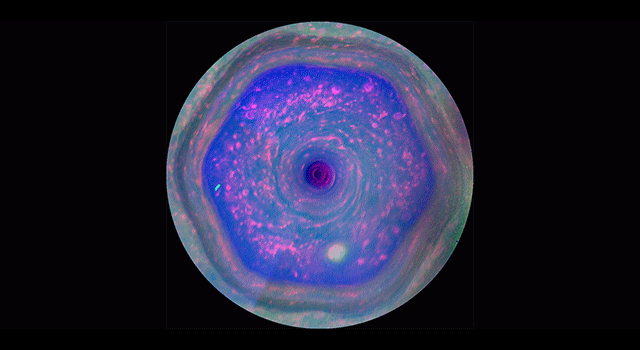Space: What is the Mystery Behind Saturn's Hexagonal Storm?

The unusual hexagonal shape surrounding Saturn's north pole was first spotted three decades ago and has remained a mystery ever since.
The hexagon, which measures 20,000 miles in diameter, is a six-sided jet stream of intense winds. A storm with such regular geometry has never been seen in the solar system before, yet research led by the Planetary Sciences Group has solved the mystery of how the phenomenon operates.
While studying the planet's bizarre geometric pattern, astronomers also discovered how often Saturn rotates - the only planet in which the rotation period is unknown.
What is Saturn's hexagon?
Launched in 1977, Nasa's Voyager 1 and 2 spacecraft passed by Jupiter and Saturn before continuing towards interstellar space. They passed Saturn in the early 1980s, which is located approximately 1,500 million km from the Sun.

The spacecraft observed an unusual, hexagon-shaped structure in the planet's uppermost clouds, surrounding its north pole.
The shape remained virtually static, in relation to the planet's overall rotation which was unknown.
Inside the hexagon, a scene of chaos was captured by probes inside the Voyager.
Clouds were being dragged along by 400km per hour winds inside the hexagon, which researchers have described as a "jet stream".
What do we know now?
Thirty years later, which is the equivalent of one Saturn year (the time the planet takes to orbit the Sun), researchers from the Polytechnic University of Valencia and the University of the Basque Country have revealed the hexagon is stable.
By measuring the positions of the hexagon vertices, researchers have determined that the storms movement remains extremely stable. The results also showed that the jet stream remained unchanged, on the basis of cloud movement.
Researchers suggest that the hexagon and its stream are the manifestation of a Rossby wave, giant meander in high-altitude winds which have a major influence on weather. Such phenomena manifest in the mid-latitudes of Earth, in which the jet stream meanders from west to east, bringing systems of areas of low pressure and anticyclones which we have been seeing regularly on weather maps.
For the study, the teams used images taken from Earth between 2008 and 2014. The images were taken by the astronomical cameras PlanetCam and Astralux. Images were also obtained by the Cassini spacecraft, which has been orbiting Saturn since 2004.
Saturn's polar atmosphere undergoes intense seasonable variations with long polar nights lasting around seven years, due to the planet's tilt of around 27 degrees. After the polar nights comes 23 years of illumination.
Yet the seasonal variations do not affect the hexagon and its jet stream, proving that both are part of an extensive wave, rooted in Saturn's atmosphere.
What is the link between the jet stream and the planet's rotation?
Agustín Sánchez-Lavega, head of the Planetary Sciences research group, said that on Saturn "the hexagonal wavy motion of the jet stream is expected to be propagated vertically and reveal to us aspects of the planet's hidden atmosphere".
This, in turn, reveals more about the rotation period of the planet, which was previously unknown.
Sánchez-Lavega explained: "The movement of the hexagon could therefore be linked to the depths of Saturn, and the rotation period of this structure, which, as we have been able to ascertain, is 10 hours, 39 minutes and 23 seconds, could be that of the planet itself."
The research was published in Geophysical Research Letters.
© Copyright IBTimes 2025. All rights reserved.






















